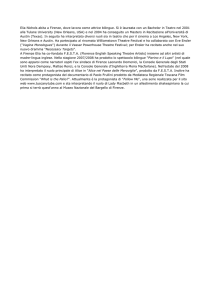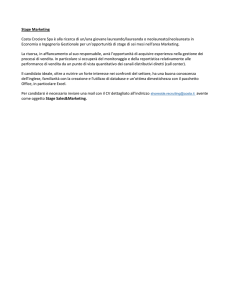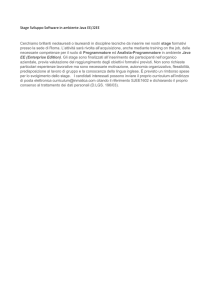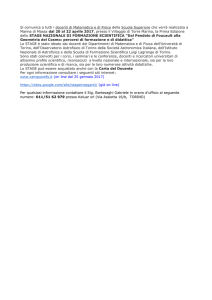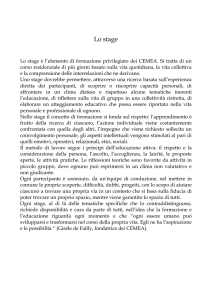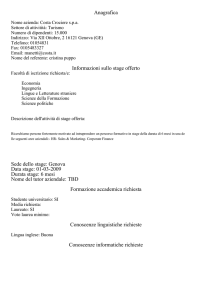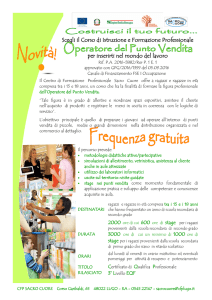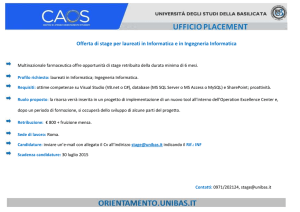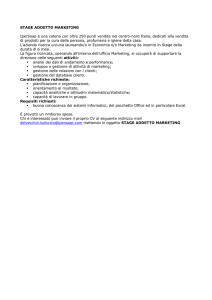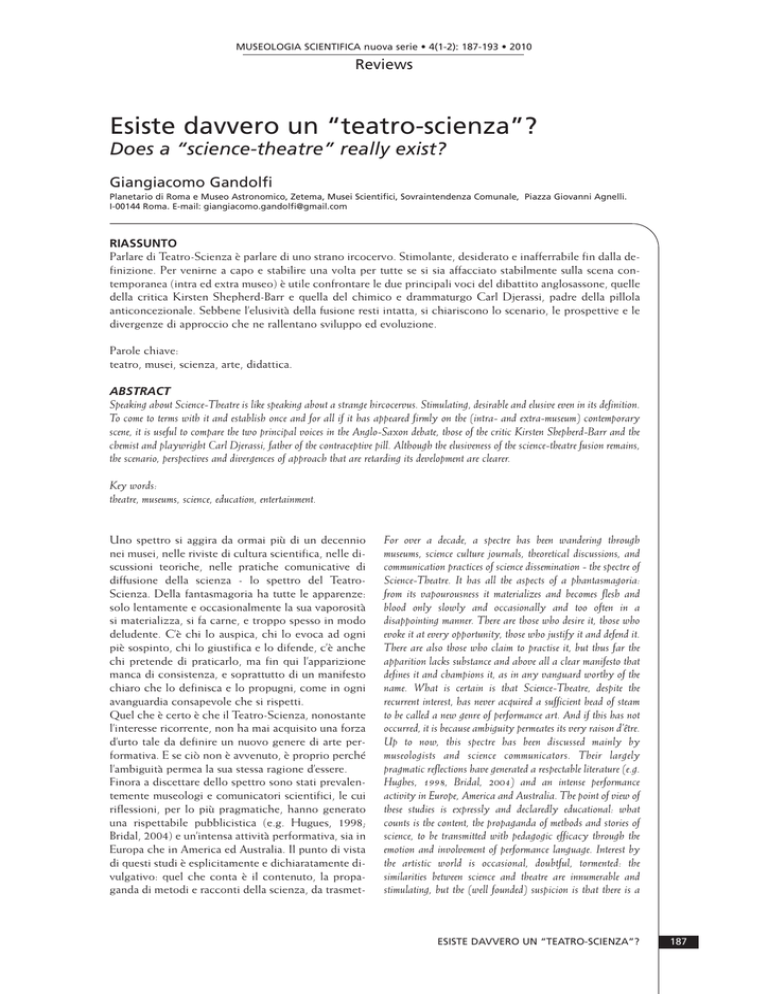
MUSEOLOGIA SCIENTIFICA nuova serie • 4(1-2): 187-193 • 2010
Reviews
Esiste davvero un “teatro-scienza”?
Does a “science-theatre” really exist?
Giangiacomo Gandolfi
Planetario di Roma e Museo Astronomico, Zetema, Musei Scientifici, Sovraintendenza Comunale, Piazza Giovanni Agnelli.
I-00144 Roma. E-mail: [email protected]
RIASSUNTO
Parlare di Teatro-Scienza è parlare di uno strano ircocervo. Stimolante, desiderato e inafferrabile fin dalla definizione. Per venirne a capo e stabilire una volta per tutte se si sia affacciato stabilmente sulla scena contemporanea (intra ed extra museo) è utile confrontare le due principali voci del dibattito anglosassone, quelle
della critica Kirsten Shepherd-Barr e quella del chimico e drammaturgo Carl Djerassi, padre della pillola
anticoncezionale. Sebbene l’elusività della fusione resti intatta, si chiariscono lo scenario, le prospettive e le
divergenze di approccio che ne rallentano sviluppo ed evoluzione.
Parole chiave:
teatro, musei, scienza, arte, didattica.
ABSTRACT
Speaking about Science-Theatre is like speaking about a strange hircocervus. Stimulating, desirable and elusive even in its definition.
To come to terms with it and establish once and for all if it has appeared firmly on the (intra- and extra-museum) contemporary
scene, it is useful to compare the two principal voices in the Anglo-Saxon debate, those of the critic Kirsten Shepherd-Barr and the
chemist and playwright Carl Djerassi, father of the contraceptive pill. Although the elusiveness of the science-theatre fusion remains,
the scenario, perspectives and divergences of approach that are retarding its development are clearer.
Key words:
theatre, museums, science, education, entertainment.
Uno spettro si aggira da ormai più di un decennio
nei musei, nelle riviste di cultura scientifica, nelle discussioni teoriche, nelle pratiche comunicative di
diffusione della scienza - lo spettro del TeatroScienza. Della fantasmagoria ha tutte le apparenze:
solo lentamente e occasionalmente la sua vaporosità
si materializza, si fa carne, e troppo spesso in modo
deludente. C’è chi lo auspica, chi lo evoca ad ogni
piè sospinto, chi lo giustifica e lo difende, c’è anche
chi pretende di praticarlo, ma fin qui l’apparizione
manca di consistenza, e soprattutto di un manifesto
chiaro che lo definisca e lo propugni, come in ogni
avanguardia consapevole che si rispetti.
Quel che è certo è che il Teatro-Scienza, nonostante
l’interesse ricorrente, non ha mai acquisito una forza
d’urto tale da definire un nuovo genere di arte performativa. E se ciò non è avvenuto, è proprio perché
l’ambiguità permea la sua stessa ragione d’essere.
Finora a discettare dello spettro sono stati prevalentemente museologi e comunicatori scientifici, le cui
riflessioni, per lo più pragmatiche, hanno generato
una rispettabile pubblicistica (e.g. Hugues, 1998;
Bridal, 2004) e un’intensa attività performativa, sia in
Europa che in America ed Australia. Il punto di vista
di questi studi è esplicitamente e dichiaratamente divulgativo: quel che conta è il contenuto, la propaganda di metodi e racconti della scienza, da trasmet-
For over a decade, a spectre has been wandering through
museums, science culture journals, theoretical discussions, and
communication practices of science dissemination - the spectre of
Science-Theatre. It has all the aspects of a phantasmagoria:
from its vapourousness it materializes and becomes flesh and
blood only slowly and occasionally and too often in a
disappointing manner. There are those who desire it, those who
evoke it at every opportunity, those who justify it and defend it.
There are also those who claim to practise it, but thus far the
apparition lacks substance and above all a clear manifesto that
defines it and champions it, as in any vanguard worthy of the
name. What is certain is that Science-Theatre, despite the
recurrent interest, has never acquired a sufficient head of steam
to be called a new genre of performance art. And if this has not
occurred, it is because ambiguity permeates its very raison d’être.
Up to now, this spectre has been discussed mainly by
museologists and science communicators. Their largely
pragmatic reflections have generated a respectable literature (e.g.
Hughes, 1998, Bridal, 2004) and an intense performance
activity in Europe, America and Australia. The point of view of
these studies is expressly and declaredly educational: what
counts is the content, the propaganda of methods and stories of
science, to be transmitted with pedagogic efficacy through the
emotion and involvement of performance language. Interest by
the artistic world is occasional, doubtful, tormented: the
similarities between science and theatre are innumerable and
stimulating, but the (well founded) suspicion is that there is a
ESISTE DAVVERO UN “TEATRO-SCIENZA”?
187
Fig. 1. Compagnia CIAC - 10 Piccole Storie della Guerra di Troia - regia di Luigi Saravo - Planetario di Roma, 2008.
Compagnia CIAC - “10 Short Stories of the Trojan War” - directed by Luigi Saravo - Rome Planetarium, 2008.
tere con efficacia pedagogica attraverso l’emozione e
il coinvolgimento del linguaggio performativo. Da
parte del mondo artistico l’interesse è ben più occasionale, dubbioso, tormentato: le analogie tra scienza e teatro sono innumerevoli e stimolanti, ma il
sospetto (ben fondato) è che si voglia trasformare il
palcoscenico e la rappresentazione in un mezzo, in
uno strumento educativo accattivante piuttosto che
in un fine artistico, piuttosto che nella creazione di
un “altro” mondo, di un’“altra” modalità espressiva e
percettiva (per una plastica rappresentazione delle
desire to transform the stage and the performance into a means,
into a fascinating educational tool rather than an artistic goal,
rather than the creation of a “different” world, of a “different”
expressive and perceptive modality (for a plastic presentation of
the positions in play, it is useful to read the interviews of science
communicators and directors in Magni, 2003). The ambiguity
is all in this dichotomy: on the one hand the almost missionary
zeal that combines a naked communication form with its
autonomous historical characteristics, on the other hand the
fascination for a world intuited as fundamental for
contemporary experience, full of dark, unknown sides difficult to
Fig. 2. Arcadia: Una scena di Arcadia di Tom Stoppard, New York, 2001.
A scene from “Arcadia” by Tom Stoppard, New York, 2001.
188
GIANGIACOMO GANDOLFI
PAG 187-193 GANDOLFI_MARCHIS VITTORIO CAPITOLO 30/03/12 09.47 Pagina 189
posizioni in gioco è utile scorrere le interviste di
comunicatori scientifici e registi in Magni, 2003).
L’ambiguità è tutta in questa dicotomia: da una parte
lo zelo quasi missionario che sposa una forma comunicativa spogliata dei suoi connotati storici autonomi, dall’altra il fascino per un mondo intuito come
fondamentale per l’esperienza contemporanea, pieno
di lati oscuri, ignoti e di difficile decifrazione, ma
allo stesso tempo invasivo, assolutizzante, minaccioso nella sua pretesa di rendere ancillare e utilitaristica la messa in scena.
Un passo in avanti, uno spariglio nella situazione di
stallo, è quello tentato nel 2006 da Kirsten
Shepherd-Barr con il suo “Science on Stage”, il primo studio accademico esteso dell’argomento, che
nasce dall’esperienza di una critica teatrale, guarda
caso completamente estranea al mondo della scienza
e della comunicazione scientifica. Lodevole sforzo
quello della Shepherd-Barr, che traccia una completa
genealogia del cosiddetto “science play”, il dramma
scientifico, individuandone peculiarità e nuovi orizzonti espressivi, ma senza riuscire a sfuggire completamente alle incongruenze e alle forzature.
Per delimitare il campo d’indagine e sostenere la tesi
dell’esistenza di un vero e proprio genere che nasce
dalla intersezione tra teatro e scienza, la studiosa si
vede costretta ad allargare il più possibile la rete,
scegliendone una definizione debole. Lo science
play viene caratterizzato come rappresentazione
scenica che comprende nel cast scienziati (buoni o
malvagi) e si basa su vere idee scientifiche, sfruttate
per complesse discussioni etiche. Il punto forse più
qualificante della definizione, espressamente dichiarato nell’introduzione ma lasciato di quando in quando cadere opportunisticamente, è l’interdipendenza
di forma e contenuto, ossia il riflettersi dei metodi e
delle teorie in discussione a livello di drammaturgia,
scenografia e gesto performativo.
Ad una individuazione blanda corrisponde una casistica prevedibilmente molto ampia, che comprende
ogni genere di linguaggio, dal realismo alla commedia, dal teatro brechtiano a quello documentario.
Dal “Faust” di Marlowe ad “Infinities” di Ronconi
l’elenco è impressionante e interminabile. Una straordinaria ricchezza da un certo punto di vista, ma
anche un limite formidabile alla riconoscibilità del
“format”, ciò che lascia nel limbo dell’impalpabilità
lo spettro del Teatro-Scienza, destinato ad
incontrare di tanto in tanto uno straordinario successo di pubblico (è il caso paradigmatico di
“Copenhagen” di Frayn) ma incapace di consolidare
un fertile e omogeneo movimento di idee, di
garantire una visibilità diffusa, di aprire finestre
stabili nei cartelloni delle principali istituzioni
teatrali.
Il fatto che la studiosa si concentri su rappresentazioni teatrali da palcoscenico - science play
Fig. 3. Locandina di Copenhagen di Michael
Frayn, Ginevra, 2011.
Playbill of “Copenhagen” by Michael Frayn, Geneva, 2011.
decipher but at the same time invasive, taken to extremes,
threatening in its pretension to render the stage performance
ancillary and utilitarian.
A step forward, a crack in the stalemate situation, was
attempted in 2006 by Kirsten Shepherd-Barr with her “Science
on Stage”. This was the first extensive academic study of the
subject, born from the experience of a theatre critic, significantly
extraneous to the world of science and science communication.
Hers was a praiseworthy effort, which traced a complete
genealogy of the so-called “science play”, identifying its
peculiarities and new expressive horizons but without managing
to completely avoid incongruities and forced interpretations.
To delimit the field of investigation and support the hypothesis
of the existence of a true genre originating from the intersection
between theatre and science, Shepherd-Barr was forced to open
the net as wide as possible, choosing a weak definition. The
science play is characterized as a stage performance including
scientists (good or evil) in its cast and based on real scientific
ideas used for complex ethical discussions. Perhaps most
interesting point of the definition, expressly declared in the
introduction but left to fall opportunistically from time to time,
is the interdependence of form and content, i.e. the reflection of
scientific methods and theories at the level of dramaturgy,
scenography and performance gesture.
A bland characterization is accompanied by a predictably
ample case study, including every kind of language, from
realism to comedy, from Brechtian theatre to documentary
theatre. From Marlowe’s “Doctor Faustus” to Ronconi’s
“Infinities”, the list is impressive and endless. An extraordinary
ESISTE DAVVERO UN “TEATRO-SCIENZA”?
189
appunto - è di per sé estremamente significativo:
ignorare l’intero spettro performativo e dunque anche il grosso delle attività di animazione museale o
di ricostruzione storica, puntando tutto sul settore
più ambizioso - la scena teatrale più o meno
mainstream - indica consapevolezza della vera posta
in gioco, e cioé dell’integrazione di alto livello del
mondo scientifico, con i suoi metodi, i suoi risultati
e i suoi dilemmi, nell’alveo della cultura generale.
Fuori dagli steccati pedagogici o didascalici, oltre gli
schematismi ideologici anche involontari, magari
indotti dal semplice contesto museale o espositivo
col suo pregiudiziale carico di aspettative di
apprendimento.
Tuttavia lo science play non è affatto visto o auspicato come esclusivamente confinato in uno spazio
fisico convenzionale, anzi. L’evoluzione di un campo
di forze così eterogeneo, la vera compenetrazione
tra problematiche scientifiche e linguaggi e tradizioni teatrali, non può che condurre verso nuove
forme di comunicazione ibride, in direzione di quel
che la Shepherd-Barr definisce “post-dramatic
science play”. Teatro di regia, con la sempre più
frequente eliminazione della componente drammaturgica, con la collaborazione diretta tra regista e
scienziati, con una crescente frammentazione scenica, con una incessante moltiplicazione di punti di
vista e una cruda giustapposizione di immagini e
testi. Gli esempi di questa tendenza in effetti pro liferano rapidamente sui palcoscenici contemporanei, e la studiosa non manca di citare Ronconi, il
Theatre de Complicité, il Theater Feuilleton 2 di
Peyret (a cui si potrebbero aggiungere alcune produzioni de La Fura dels Baus e della Societas
Raffaello Sanzio). La mancanza di compattezza e
l’impalpabilità odierna del Teatro-Scienza vengono
così sanate in prospettiva futura, in vista di un
probabile perfezionamento della fusione in chiave
sperimentale. Se il lavoro della critica inglese non
costituisce in alcun modo un manifesto, uno sprone
alla compiuta materalizzazione del nostro spettro,
traccia tuttavia un percorso asintotico, un orizzonte
di felice sintesi artistica.
Allo sforzo di sistematizzazione critica della
Shepherd-Barr risponde con una forte presa di
posizione teorica lo scienziato-drammaturgo Carl
Djerassi (Djerassi, 2007) , che fa riemergere da un
punto di vista militante la vecchia contrapposizione
tra “Scienza-Teatro” (“what can the stage do for
science?”) e “Teatro-Scienza” (“what can science do
for the stage?”). Il chimico Djerassi ha buon gioco
nello smontare lo sterminato catalogo di science
play proposto da “Science on stage”, e si compiace
nel mettere al bando le troppe opere scarsamente
rappresentate, i drammi in cui compaiono stereotipi
senza connessione con la scienza vera, i puri e
semplici reading. Giustamente la quantità non è
190
GIANGIACOMO GANDOLFI
Fig. 4. Una scena di Copenhagen, Udine, 2009 Foto di Marco Caselli.
A scene from “Copenhagen”, Udine, 2009 - Photograph by Marco Caselli.
wealth from a certain point of view, but also a formidable limit
to recognisability of the “format”. This is what leaves the spectre
of Science-Theatre in the limbo of impalpability, destined to
achieve extraordinary success with the public from time to time
(this is the paradigmatic case of Frayn’s “Copenhagen”) but
incapable of consolidating a fertile and homogeneous movement
of ideas, of assuring widespread visibility, of gaining a stable
place on the playbills of the main theatrical institutions.
The fact that Shepherd-Barr concentrates on theatrical stage
presentations - viz. science play - is extremely significant per
se: ignoring the entire performance spectrum and thus most of
museum entertainment activities or historical reconstructions,
betting all on the most ambitious sector (the more or less
mainstream theatrical scene), indicates an awareness of the true
objective, i.e. the high-level integration of the scientific world,
with its methods, results and dilemmas, into the heart of general
culture - outside pedagogical or didactic stockades, beyond even
unintentional ideological schematisms, perhaps induced by the
simple museum or display context with its prejudicial burden of
learning expectations.
However, the science play is not viewed (or desired) as
exclusively confined in a conventional physical space, on the
contrary. The development of such a heterogeneous field, the
combination of scientific subjects and theatrical languages and
traditions, can only lead to new forms of hybrid
communication, toward what Shepherd-Barr calls the “post-
Fig. 5. Una scena di Vita di Galileo, Cleveland, 2011.
A scene from “Life of Galileo”, Cleveland, 2011.
sinonimo di qualità, e non è sufficiente citare un
testo, neanche uno teatrale, senza preoccuparsi della
sua assoluta pertinenza o del suo “impact factor” (per
usare una metafora scientifica). I nodi vengono al
pettine, però, quando Djerassi chiarisce la sua definizione di “science play” ideale, che non a caso diventa “science-in-theater”. Non stupisce che della
lista della Shepherd-Barr restino poche briciole (e tra
quelle l’integrale delle sue opere), dal momento che
il genere deve essere caratterizzato da: 1) insostituibilità dell’elemento scientifico (ovverosia inesistenza
della pièce se le si sottrae la scienza) e 2) insufficienza di un ruolo meramente metaforico di quello
stesso elemento.
Se il primo punto appare un criterio soddisfacente e
meritevole di ulteriore indagine, il secondo sottostima enormemente il potenziale metaforico della
scienza, il suo valore di fondamentale grimaldello
nella complessa operazione di integrazione della cultura scientifica in quella più generale a predominan za umanistica.
C’è di più. Consapevole del rischio insito nell’aggressivo purismo della definizione di “science in
theater”, Djerassi mette le mani avanti e ricorda l’aforisma di Quinto Orazio Flacco nella sua Ars Poetica:
“Lectorem delectando pariterque monendo”, il
pubblico va divertito e allo stesso tempo ammae strato. Tutto starebbe dunque nel dosare corret tamente le proporzioni. I due unici poli tra cui si
muove il teatro diventerebbero così l’education e
dramatic science play”: theatre of the director, with the ever more
frequent elimination of the dramaturgical component, with direct
collaboration between director and scientists, with increasing
scenic fragmentation, with an incessant multiplication of
perspectives and a crude juxtaposition of images and texts.
Examples of this tendency are rapidly proliferating on
contemporary stages, and Shepherd-Barr does not fail to cite
Ronconi, the Theatre de Complicité, the Theatre Feuilleton 2 of
Peyret (to which could be added some productions of La Fura
dels Baus and the Societas Raffaelo Sanzio). Hence, the current
lack of compactness and the impalpability of Science-Theatre
are rectified in a future perspective, in view of a probable
experimental perfecting of the fusion. Although the English
critic’s work does not constitute a manifesto, a spur to the
successful materialization of our spectre, it nevertheless traces an
asymptotic path, a horizon of a fortunate artistic synthesis.
The scientist-playwright Carl Djerassi (Djerassi, 2007)
responds to Shepherd-Barr’s effort at critical systematization
with a strong theoretical position. He revives, from a militant
point of view, the old opposition between “Theatre-Science”
(“what can the stage do for science?”) and “Science-Theatre”
(“what can science do for the stage?”). The prize-winning
chemist has an easy time dismantling the interminable catalogue
of science plays proposed by “Science on Stage”, and takes
pleasure in banning the many infrequently performed works, the
plays containing stereotypes without a connection to true
science, the pure and simple readings. Correctly, quantity is not
synonymous with quality, and it is not sufficient to cite a text,
not even a theatrical one, without considering its absolute
ESISTE DAVVERO UN “TEATRO-SCIENZA”?
191
l’entertainment, impoverendo in modo imbarazzante
un’arte ricca e millenaria, una modalità di creazione
ed espressione corporea dalle mille sfumature. Riducendo il palcoscenico non a laboratorio di scoperta
dell’uomo e della natura, ad alto momento di riflessione, appropriazione e trasfigurazione del fatto
scientifico, ma ad aula universitaria mascherata da
vaudeville, a passatempo utile e istruttivo.
Dopo aver esaminato le due principali e più nette
posizioni del dibattito contemporaneo, resta intatta
ed appropriata la domanda che apre la presente riflessione. Esiste davvero qualcosa che si possa definire “Teatro-Scienza”? Ha finalmente preso forma,
dopo anni di dibattito e incitamento, un nuovo genere da palcoscenico focalizzato su temi scientifici?
In fondo nello stesso periodo abbiamo visto emergere chiaramente in Italia un Teatro di Narrazione,
una scuola performativa basata su memoria e
inchiesta di valore politico-sociale (Paolini, Baliani e
Celestini ad esempio), abbiamo verificato insomma
che un nuovo approccio alla scena, alla drammaturgia e ai loro contenuti è possibile.
La risposta, tuttavia, resta necessariamente sfumata,
complessa, ricca di chiaroscuri.
Il tema dell’incontro tra performance attoriale e
mondo scientifico è sicuramente ben più vasto che la
corretta definizione di “science play”, o la introduzione di un nuovo genere teatrale. Esiste - lo abbiamo detto - un continuum di possibili interazioni tra
scienza e messa in scena, spesso minimali o dilettantistiche, la maggior parte delle quali viene effettivamente praticata in ambiente museale o in contesto
scolastico. Attività legittimamente orientate alla didattica o alla pura sensibilizzazione tematica, lontane da preoccupazioni teoriche e velleità artistiche.
Questo “Teatro-Scienza” indubbiamente esiste e fiorisce rigoglioso, spesso con ottimi risultati, se valutati con ottica utilitaristica. Se ne può trovare un’ampia trattazione, con i suoi sottogeneri e la distin zione tra “museum theatre” e “live interpretation”, sul
sito dell’associazione IMTAL (International Museum
Theatre Alliance).
Altra cosa è valutare l’estremo “nobile” del
continuum, lo “science play” della Shepherd Barr o il
restrittivo “science in theater” di Djerassi, che
rappresentano il momento di maggior impatto culturale nell’incontro tra due mondi né troppo lontani
né troppo vicini. In questa accezione limitata il
“Teatro-Scienza” era e resta uno spettro intangibile,
una nube irrisolta in cui di tanto in tanto si solidi ficano isolate produzioni di successo, di fatto finora
incapaci di creare un seguito permanente, una scuola
riconosciuta.
Come sottolinea Djerassi, al di là delle divergenze
metodologiche e dei contrasti nell’obiettivo finale,
sia lui che la critica inglese auspicano lo sprigionarsi
di stabili energie creative, ma ambedue non possono
192
GIANGIACOMO GANDOLFI
Fig. 6. Una scena di Copenhagen, Vero Beach,
FL, 2011.
A scene from “Copenhagen”, Vero Beach, FL, 2011.
pertinence or its “impact factor” (to use a scientific metaphor).
The true sins are revealed, however, when Djerassi clarifies his
definition of ideal “science play”, which not by chance becomes
“science-in-theatre”. It is not surprising that only a few crumbs
of Shepherd-Barr’s list remain (and among them all of
Djerassi’s works), since the genre must be characterized by: 1)
irreplaceable nature of the scientific element (i.e. the play cannot
exist if science is subtracted from it), and 2) insufficiency of a
merely metaphorical role of science.
Although the first point appears to be a satisfactory and
deserving criterion for further investigation, the second
enormously underestimates the metaphorical potential of science,
its value as a fundamental key in the complex operation of
integrating scientific culture into the more general,
predominantly humanistic culture.
And there is more. Aware of the risk inherent in the aggressive
purism of the definition of “science-in-theatre”, Djerassi takes the
safe route and recalls the aphorism of Horace in his “Ars
Poetica”: “Lectorem delectando pariterque monendo”, i.e. the
public should be amused and instructed at the same time. Hence,
it is all in correctly dosing the proportions. Education and
entertainment should become the only two poles between which
theatre moves, impoverishing in an embarrassing manner a rich
and age-old art, a modality of creation and bodily expression
with a thousand nuances. This would reduce the stage not to a
laboratory for the discovery of man and nature, to a high
moment of reflection, appropriation and transfiguration of the
che indicare allo stato dei fatti un bicchiere mezzo
vuoto o mezzo pieno (anche se magari in rapido
riempimento). Più che uno spettro, forse, un gatto di
Schrodinger bloccato in un palcoscenico dal sipario
socchiuso, sospeso tra esistenza e inesistenza. A
decidere lo stato finale non può che essere il raggiungimento di una massa critica di interesse reciproco, da parte del mondo scientifico (e di quello
della comunicazione della scienza, magari intensificando le commissioni, la discussione, la creazione
di laboratori di sperimentazione, le produzioni
congiunte) come di quello teatrale (drammaturghi,
registi, compagnie ed istituzioni preposte, in qualche modo sensibili al fascino delle tematiche e dei
linguaggi scientifici). Senza mai dimenticare ovviamente il ruolo insostituibile dell’osservatore, in questo caso il grande pubblico dei festival e dei teatri
locali e nazionali.
BIBLIOGRAFIA / REFERENCES
BRIDAL T., 2004. Exploring Museum Theatre. Walnut
Creek, CA: AltaMira Press, 197 pp.
DJERASSI C., 2007. When is Science on Stage” really
Science?. American Theatre, 24: 96-103
HUGUES C., 1998. Museum Theatre: Communicating with
Visitors through Drama. Portsmouth, NH: Heinemann
Press, 152 pp.
SHEPHERD-BARR K., 2006. Science on Stage. Princeton
University Press, 264 pp.
Siti web / Web sites
(accessed 25.01.12)
Sito Istituzionale dell’International Museum Theatre
Alliance: http://www.imtal.org/
Magni F.: “Teatro e Scienza”, 2003 sul sito del
webmagazine Erewhon
http://erewhon.ticonuno.it/riv/scienza/t-s/te-sc.htm
scientific fact, but to a university lecture hall masked by
vaudeville, to a useful and instructive pastime.
After this examination of the two principal and clearest
positions of the contemporary debate, the question that opened
this essay remains intact and appropriate. Does something truly
exist that can be called “Science-Theatre”? After years of debate
and urging, has a new stage genre focusing on scientific topics
finally taken form? After all, in the same period we have seen a
Narration Theatre clearly emerge in Italy, a performance school
based on political-social memory and investigation (Paolini,
Baliani and Celestini, for instance), and we have verified that a
new approach to the stage, to dramaturgy and to their contents
is possible. The answer, nevertheless, necessarily remains vague,
complex and rich in nuances.
The matter of the encounter between stage performance and
science is certainly much broader than the correct definition of
“science play” or the introduction of a new theatrical genre.
There is – as we have said – a continuum of possible
interactions between science and the stage, often minimal or
amateur, most of which effectively practised in a museum or in a
school. It is an activity legitimately oriented to teaching or to
pure subject sensitization, far from theoretical worries and
artistic pretensions. This “Science-Theatre” undoubtedly exists
and is blossoming, often with excellent results when evaluated
from a utilitarian perspective. An ample treatment of it, with its
subgenres and the distinction between “museum theatre” and “live
interpretation”, can be found at the IMTAL (International
Museum Theatre Alliance) web site.
It is another thing to evaluate the “noble” end of the continuum,
Shepherd-Barr’s “science play” or Djerassi’s restrictive “sciencein-theatre”, which represents the moment of greatest cultural
impact in the meeting of two worlds which are neither too distant
nor too near. In this limited meaning, “Science-Theatre” was
and remains an intangible spectre, an unresolved cloud in
which, from time to time, we see isolated productions that achieve
success but thus far have been incapable of creating a permanent
continuation, a recognized school.
As Djerassi underlines, beyond the methodological divergences
and contrasts about the final objective, both he and ShepherdBarr hope for an unleashing of stable creative energies, but both
can merely indicate either a glass half empty or a glass full half
(albeit perhaps rapidly filling). More than a spectre, perhaps we
are dealing with a Schrödinger’s cat blocked on a stage with the
curtain left half open, suspended between existence and nonexistence. The final state can only be decided by the attainment
of a critical mass of mutual interest, by the scientific world (and
that of science communication, perhaps by intensifying the
commissions, the discussion, the creation of experimental
laboratories and combined productions) and by the theatrical
world (playwrights, directors, companies and institutions in
some way sensitive to the fascination of scientific subjects and
languages). But obviously without ever forgetting the
irreplaceable role of the observer, in this case the large public of
festivals and local and national theatres.
ESISTE DAVVERO UN “TEATRO-SCIENZA”?
193


